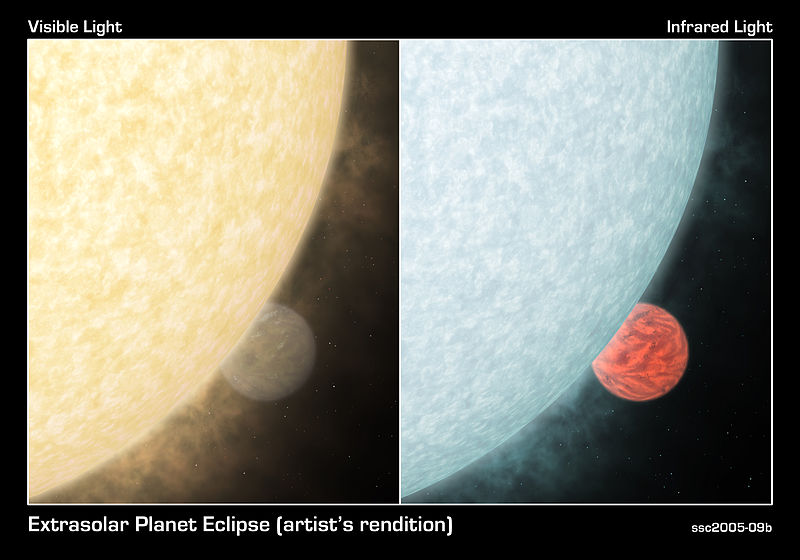File:Blinded by the Light.jpg
From Wikimedia Commons, the free media repository
Jump to navigation
Jump to search

Size of this preview: 800 × 560 pixels. Other resolutions: 320 × 224 pixels | 640 × 448 pixels | 1,024 × 717 pixels | 1,280 × 896 pixels | 2,560 × 1,792 pixels | 3,000 × 2,100 pixels.
Original file (3,000 × 2,100 pixels, file size: 1.92 MB, MIME type: image/jpeg)
File information
Structured data
Captions
Captions
Add a one-line explanation of what this file represents
Summary[edit]
| DescriptionBlinded by the Light.jpg |
English: This artist's concept shows what a fiery hot star and its close-knit planetary companion might look close up if viewed in visible (left) and infrared light. In visible light, a star shines brilliantly, overwhelming the little light that is reflected by its planet. In infrared, a star is less blinding, and its planet perks up with a fiery glow.Astronomers using NASA's Spitzer Space Telescope took advantage of this fact to directly capture the infrared light of two previously detected planets orbiting outside our solar system. Their findings revealed the temperatures and orbits of the planets. Upcoming Spitzer observations using a variety of infrared wavelengths may provide more information about the planets' winds and atmospheric compositions.In this figure, the colors represent real differences between the visible and infrared views of the system. The visible panel shows what our eyes would see if we could witness the system close up. The hot star is yellow because, like our Sun, it is brightest in yellow wavelengths. The warm planet, on the other hand, is brightest in infrared light, which we can't see. Instead, we would see the glimmer of star light that the planet reflects.In the infrared panel, the colors reflect what our eyes might see if we could retune them to the invisible, infrared portion of the light spectrum. The hot star is less bright in infrared light than in visible and appears fainter. The warm planet peaks in infrared light, so is shown brighter. Their hues represent relative differences in temperature. Because the star is hotter than the planet, and because hotter objects give off more blue light than red, the star is depicted in blue, and the planet, red.The overall look of the planet is inspired by theoretical models of hot, gas giant planets. These "hot Jupiters" are similar to Jupiter in composition and mass, but are expected to look quite different at such high temperatures. |
| Date | |
| Source | http://planetquest.jpl.nasa.gov/image/27# |
| Author | NASA/JPL-Caltech/R. Hurt (SSC/Caltech) |
Licensing[edit]
| Public domainPublic domainfalsefalse |
| This file is in the public domain in the United States because it was solely created by NASA. NASA copyright policy states that "NASA material is not protected by copyright unless noted". (See Template:PD-USGov, NASA copyright policy page or JPL Image Use Policy.) |  | |
 |
Warnings:
|
File history
Click on a date/time to view the file as it appeared at that time.
| Date/Time | Thumbnail | Dimensions | User | Comment | |
|---|---|---|---|---|---|
| current | 16:36, 27 January 2013 |  | 3,000 × 2,100 (1.92 MB) | Stas1995 (talk | contribs) | User created page with UploadWizard |
You cannot overwrite this file.
File usage on Commons
There are no pages that use this file.
Metadata
This file contains additional information such as Exif metadata which may have been added by the digital camera, scanner, or software program used to create or digitize it. If the file has been modified from its original state, some details such as the timestamp may not fully reflect those of the original file. The timestamp is only as accurate as the clock in the camera, and it may be completely wrong.
| Author | Spitzer Space Telescope |
|---|---|
| Copyright holder | http://www.spitzer.caltech.edu/Media/mediaimages/copyright.shtml |
| Image title |
|
| Short title |
|
| Credit/Provider | NASA/JPL-Caltech/R. Hurt (SSC/Caltech) |
| Headline | This artist's concept shows what a fiery hot star and its close-knit planetary companion might look close up if viewed in visible (left) and infrared light. In visible light, a star shines brilliantly, overwhelming the little light that is reflected by its planet. |
| Source | Spitzer Space Telescope |
| Date and time of data generation | 22 March 2005 |
| Width | 3,000 px |
| Height | 2,100 px |
| Bits per component |
|
| Compression scheme | LZW |
| Pixel composition | RGB |
| Orientation | Normal |
| Number of components | 3 |
| Horizontal resolution | 300 dpi |
| Vertical resolution | 300 dpi |
| Data arrangement | chunky format |
| Software used | Adobe Photoshop CS3 Macintosh |
| File change date and time | 14:52, 13 February 2009 |
| Color space | sRGB |
| Contact information |
http://www.spitzer.caltech.edu 1200 E. California Blvd. Pasadena, CA, 91125 USA |
| IIM version | 2 |
Hidden category: